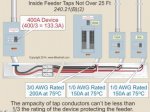You are using an out of date browser. It may not display this or other websites correctly.
You should upgrade or use an alternative browser.
You should upgrade or use an alternative browser.
Tap Conductor Temperature
- Thread starter Squantum
- Start date
- Status
- Not open for further replies.
jaggedben
Senior Member
- Location
- Northern California
- Occupation
- Solar and Energy Storage Installer
The ampacity of the conductor depends in part on its temperature rating. See table 310.15(B)(16). 8awg doesn't need to be rated at 75C to meet the ampacity requirement in the example, since 8awg rated for 60C has an ampacity of 40A. The example is showing the minimum rated conductor that would be allowed.
- Location
- New Jersey
- Occupation
- Journeyman Electrician
Also it could be referencing the somewhat moot 110.14(C)(1)(a) where conductors #14-#1 AWG are used at their 60° C ampacity. Most terminals are rated for 75° C so the 75° ampacity may be used unless you had a 60° C wiring method like NM cable.
- Location
- Chapel Hill, NC
- Occupation
- Retired Electrical Contractor
If we do not know the ampacity of the terminals then you must use 60C based on what Trevor stated. I agree that most terminals are rated 75C but if that info is not given then we must use 60C for conductors 1 awg and smaller
Tap Temp.
Tap Temp.
Thanks for your reply, I understand the rules on terminals and rating, however what has me confused is the first picture where there is a 1/0 feeding the 30 amp switch, the conductors are rated at 75 Degrees unlike the second photo 30 amp fed with #8 awg but at 60 degrees.
I know why 1/0 was selected (1/3 rule) and I know why #8 awg was selected(10% rule), but what governed the temp selection for the 30 amp switch in the first photo, (75 degrees). Perhaps both sets of terminals were implied 75 degrees. Maybe the 75 degrees is based on the 1/0? In any case the two pictorial examples contradict each other and has me confused. So I guess my question is;
What dictates the temp selection of tap conductors feeding tap devices?
1) The less than 100a more than 100a (60 degree/ 75 degree) based on the tap device OCPD.
2) or the terminal temperature.
Thanks for your input.
Tap Temp.
Thanks for your reply, I understand the rules on terminals and rating, however what has me confused is the first picture where there is a 1/0 feeding the 30 amp switch, the conductors are rated at 75 Degrees unlike the second photo 30 amp fed with #8 awg but at 60 degrees.
I know why 1/0 was selected (1/3 rule) and I know why #8 awg was selected(10% rule), but what governed the temp selection for the 30 amp switch in the first photo, (75 degrees). Perhaps both sets of terminals were implied 75 degrees. Maybe the 75 degrees is based on the 1/0? In any case the two pictorial examples contradict each other and has me confused. So I guess my question is;
What dictates the temp selection of tap conductors feeding tap devices?
1) The less than 100a more than 100a (60 degree/ 75 degree) based on the tap device OCPD.
2) or the terminal temperature.
Thanks for your input.
- Location
- New Jersey
- Occupation
- Journeyman Electrician
The two graphics depict what's in 110.14(C)(1) based on the size of the tap conductors and the equipment that they're terminated in. The 75° C conductors are all larger than #1, the 60° C conductors, the #8's, are not. If you terminate a conductor in a 60° C lug it's ampacity does exceed 60° C.
What's confusing is that they're both terminating in a 30 amp switch but to meet 110.14(C)(1) the switch that accepts #1/0 conductors would require 75° C lugs.
What's confusing is that they're both terminating in a 30 amp switch but to meet 110.14(C)(1) the switch that accepts #1/0 conductors would require 75° C lugs.
jaggedben
Senior Member
- Location
- Northern California
- Occupation
- Solar and Energy Storage Installer
Thanks for your reply, I understand the rules on terminals and rating, however what has me confused is the first picture where there is a 1/0 feeding the 30 amp switch, the conductors are rated at 75 Degrees unlike the second photo 30 amp fed with #8 awg but at 60 degrees.
I know why 1/0 was selected (1/3 rule) and I know why #8 awg was selected(10% rule), but what governed the temp selection for the 30 amp switch in the first photo, (75 degrees). Perhaps both sets of terminals were implied 75 degrees. Maybe the 75 degrees is based on the 1/0? In any case the two pictorial examples contradict each other and has me confused. So I guess my question is;
What dictates the temp selection of tap conductors feeding tap devices?
1) The less than 100a more than 100a (60 degree/ 75 degree) based on the tap device OCPD.
2) or the terminal temperature.
Thanks for your input.
Any of the wires in both examples could be 60C, but I think they picked the smallest size wire that could be used in all cases. It just happened that the 8awg was the only one where 60C could be used without needing a larger wire size. All the other wires in the examples would have to be larger if they were rated 60C.
I think the pictures assume that all terminals are rated 75C, which is usually the case in the real world.
In the real world you'd probably pay more for additional copper than for a higher temp rating, and also using smaller wire is better for fill rates and so on. So going with a smaller wire that has a higher temp rating is usually the better choice.
- Status
- Not open for further replies.


